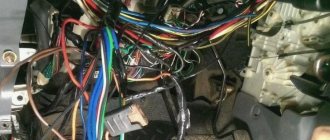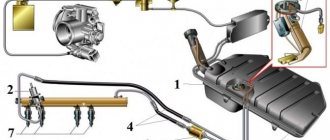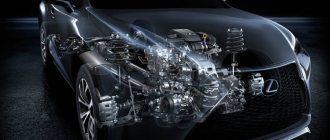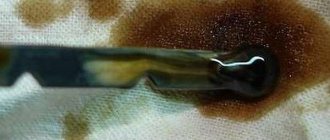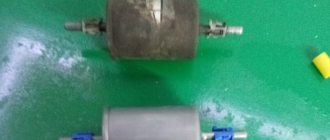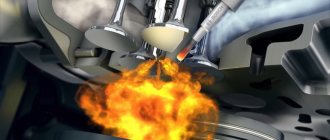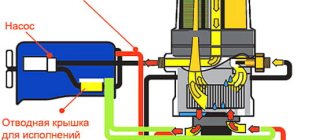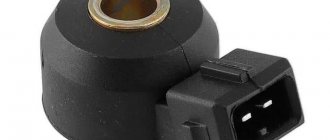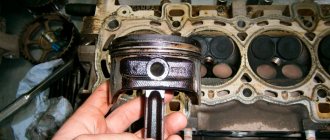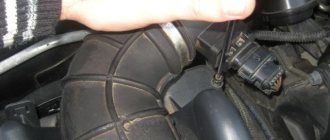Engine detonation - signs, causes, solutions video » AvtoNovator
One of the reasons for its demonstration is too early ignition, which can be determined by the characteristic loud knocking sound in the engine.
It occurs as a result of premature ignition of the combustible mixture. When the ignition timing is set correctly, the mixture ignites slightly, not reaching top dead center (2-3 degrees). That is, the outbreak begins when the piston has not yet completed its upward movement, but ends at the moment it begins to return to bottom dead center. If ignition occurs too early, a backfire occurs, which causes the unpleasant sound of engine detonation. Another reason for detonation is the use of fuel with a lower octane number than provided for by the operating rules of the vehicle.
What does this lead to? As a result of using low-octane fuel, soot (soot) forms in the combustion chamber, and this leads to critical consequences. Many drivers have encountered the fact that after turning off the ignition, the engine does not stop, but continues to run jerkily, making an unpleasant ringing sound. At such moments, hot carbon actually plays the role of a spark plug. Ignition of the fuel mixture occurs chaotically.
In a diesel engine, the air in the cylinder is compressed so much that its temperature exceeds the combustion temperature of diesel fuel. Just before the piston reaches top dead center (TDC), fuel is injected into the combustion chamber and instantly ignites. If the amount of fuel injected is excessively large, strong shock waves are generated in the cylinder, causing detonation.
Determination of flammability of diesel fuel
The flammability of diesel fuel is expressed using the cetane number (CZ). It means that the diesel fuel has the same flammability as a certain comparative mixture of cetane and a-methylnaphthalene. The highly flammable reagent in the mixture is cetane. It has a cetane number of 100, while l-methylnaphthalene has a cetane number of 0. Thus, for example, a cetane number of CZ = 55 means that diesel fuel has the same propensity to ignite as a comparative mixture of 55% (volume fractions ) cetane and 45% (volume fractions) a-methylnaphthalene. Flammability increases with increasing cetane number.
Determining the cetane number is carried out in the same way as determining the octane number of gasoline using a reference engine specifically designed for these measurements. An engine is used to evaluate the detonation resistance of gasoline using the method and a standard engine for assessing the detonation resistance of fuel materials - single-cylinder four-stroke diesel engines with a device for regulating the final compression pressure. While in an engine the final compression pressure is adjusted by restricting the intake air, in a standard engine the adjustment is done by changing the compression ratio.
Below, the measurement of cetane number 1952/54 is described using the example of a test engine developed - a four-stroke diesel engine with a swirl combustion chamber and an evaporative cooling system. It operates at a crankshaft speed of approximately 1000 min and the brake generator creates a resistive torque. First, the diesel fuel to be tested is supplied to the engine. The injection quantity should be adjusted according to the flow rate of 8 ± 0.3 cm3/min, and the injection timing should be adjusted to 20° of the crankshaft angle to top dead center. A throttle valve is installed in the engine intake manifold, and in front of it is a measuring diffuser. connected to a vacuum gauge. The throttle valve closes, thereby reducing compression pressure, until the ignition delay of the diesel fuel is equal to 20° of the crankshaft angle to top dead center and combustion begins exactly at the top dead center of the piston. The vacuum value is displayed on the display of the vacuum gauge. The flammability of diesel fuel is high when the vacuum is low. Then only a small amount of air passes through the diffuser, and the final compression pressure is low.
At the end of the diesel fuel measurement, two comparison mixtures are injected under the same conditions. The cetane number of the comparative mixtures should differ by only four units. In addition, the cetane number of the diesel fuel must be between the cetane numbers of the two comparison blends. Based on the recorded vacuum gauge readings, the cetane number of diesel fuel is calculated through linear interpolation and rounded to the nearest whole number.
The cetane numbers of modern diesel fuel are 50-55 units.
Causes of diesel engine detonation
During normal operation of the internal combustion engine, the mixture ignites when the piston is at the top point of TDC, with an advance of the ignition angle by 2 - 3 °. Afterburning of the mixture continues after TDC when the piston moves in the opposite direction. The estimated speed of movement of the flame is 30 m/sec. During an explosion, this parameter increases sharply, reaching a value of 2 thousand meters in one second.
Engine detonation occurs when:
- constant movement of the machine;
- increasing loads;
- when working in various gears;
- including at idle speed.
It is caused by violations of parameters during fuel combustion. A smooth process is instantly replaced by a strong explosion, which leads to negative consequences:
- destruction of pistons, cylinders;
- parts of the crank mechanism;
- a sharp increase in temperature;
- reduction in power characteristics;
- increase in fuel consumption.
The most common causes of engine detonation:
- Violation of regulations.
- Poor mixing of fuel with oxygen.
- Insufficient cooling system efficiency.
- Violation of operational requirements.
- Use of low octane gasoline.
- Engine design defects.
COMMON RAIL fuel system - what is it?
COMMON RAIL is a new generation diesel fuel system that has become widespread due to stricter environmental regulations. In addition to reducing the level of exhaust toxicity, this type of injection allows you to provide the required engine power with a minimum fuel supply. Literally translated, “common rail” reads as “single highway”. Let's look at the main differences, operating principles and design features of the system.
Peculiarities
One of the most obvious differences between the Common Rail fuel system is the presence of a common line located between the injectors and the injection pump, which acts as a fuel accumulator.
Unlike the scheme in which the pump directly distributed the mixture to the nozzles, in this design its role is limited to pumping diesel into the pipeline. Another feature is the electronic control system for fuel dosing in the sprayers. However, the main difference of the new generation system is a significantly higher injection pressure , which determines the quality and uniformity of the spray distribution. This factor is a key aspect of the formation of the mixture and its subsequent combustion, which determines the efficiency of the engine. Thus, the use of modern Common Rail fuel systems makes it possible to provide almost 40% increase in diesel engine power while simultaneously reducing noise levels and fuel consumption by up to 15%. In addition, the torque of the power unit increases.
The high manufacturability of the design makes this injection system demanding of fuel quality. Small abrasive particles that get into the fuel line can damage equipment manufactured with high precision.
Operating principle of the Common Rail fuel system
The operating principle of the Common Rail fuel system is to supply fuel to the nozzles from a ramp, which acts as a high-pressure preliminary accumulator. The operation of the equipment is similar to the technology of old fuel lines. The boost pump takes diesel from the tank and sends it to the fuel injection pump, which builds up pressure in the line and supplies fuel to the nozzles, which inject it into the cylinders at the required moment.
The low pressure circuit is shown in yellow, the high pressure circuit is in red, and the fuel return to the tank is in brown.
- Fuel lift pump.
- Fuel filter.
- High pressure fuel pump.
- Dosage valve.
- Fuel pressure sensor in the rail.
- High pressure accumulator - fuel rail.
- Pressure regulator (control valve).
- Injectors.
Electronic control made it possible to organize a two-stage scheme for pumping strictly dosed portions of fuel. At the first stage, the minimum required dose (about 1 mg) enters the chamber, the ignition of which increases the temperature in a closed volume, after which the main part of the fuel is injected into it. This scheme makes it possible to ensure a smooth increase in pressure in the chamber, as a result of which the power unit operates more smoothly and the noise level during its operation is significantly reduced.
Based on the data received from the sensors, the system determines the required amount of fuel, which is taken from the tank through the metering valve. Thus, the fuel first enters the pump, and through it into the “temporary accumulator”. The corresponding regulator is responsible for maintaining the required level of pressure in the rail. At a given point in time, the control unit sends a command to the injectors, and they open the dampers for a certain period of time. Depending on the operating mode of the power unit, the system can, within certain limits, automatically change the pressure and fuel volume. The pressure is calculated and maintained regardless of the crankshaft rotation speed and the amount of fuel supplied. The sprayers supply the mixture to the cylinders, receiving a control signal from the electronic unit to the solenoid.
The use of a split ignition cycle in diesel fuel systems makes it possible to increase torque at low crankshaft speeds by up to 25% while reducing fuel consumption by 20%. In addition, the degree of soot release into the exhaust is reduced, and the sound of the engine becomes much quieter.
Design
Structurally, the fuel system of a Common Rail engine is a high-pressure circuit, which is a complex complex of several interconnected components.
Injection pump . This unit is designed to pressurize fuel. Since in a diesel engine the crankshaft speed is regulated not by the throttle valve, but by the volume of fuel supplied, the injection pump is one of the most important elements in the design of the power unit.
Valve and regulator . The valve is designed to dispense a portion of fuel supplied to the pump and is structurally a part of the injection pump. The pressure regulator is located in the fuel line and controls the operation of the power plant depending on the load on it.
Ramp . This part has a wide functionality and acts as a fuel accumulator, and also distributes it among the nozzles and softens pressure drops in the liquid.
Injectors . Unlike gasoline analogues, the design of this type of nozzle is designed for significantly higher pressure. In addition, common rail injectors control the amount of fuel that enters directly into the cylinder. Modern engines use two types of nozzles:
- Electrohydraulic . In designs of this type, fuel is supplied by the operation of a solenoid valve.
- Piezo injectors . In designs of this type, the dosing of fuel is controlled by special crystals, which increase the speed of response to control signals by an order of magnitude.
Development prospects
The technological potential of the Common Rail fuel system has given new impetus to the development of diesel engines in the face of constantly rising toxicity standards. Thanks to the control of high-precision electronics and significant injection pressure, combustion of the mixture occurs with maximum efficiency, which ensures optimal operation of the power unit in each operating mode. Further technological development of the system is directly related to increasing environmental safety standards.
Similar articles
Overhaul of diesel engines becomes relevant in case of wear of parts. As a rule, this happens after the motor has exhausted its service life. That is, when the average mileage is .
Source: www.ktmagazine.ru The practice of specialized service centers shows that the service life of injectors for power supply systems of modern diesel engines largely depends on quality.
Today, three types of high-pressure fuel pumps are the most common - in-line, distribution and common rail. They differ both structurally and in operating principle. At .
The phrase “troits diesel” is familiar to every owner of a diesel car. But do you know what such a concept means and how to deal with it? So, diesel car educational program: if one of the .
Diesel detonation, external manifestations and causes
Speaking about diesel engine detonation and its causes, it is important to note the following. Instant fuel combustion is caused by the fact that the entire volume of the fuel mixture ignites simultaneously, and not gradually. In addition, the process starts earlier, even before the calculated crankshaft rotation angle, when the piston has not reached the so-called TDC.
The ignited gases instantly increase in volume, but the piston, which is just rising at this time, compresses them, as a result, the pressure in the chamber increases significantly.
The ignition of a mixture of fuel and air is actually a mini-explosion, the pressure from which acts on the walls of the cylinder, as well as on the bottom of the piston rising towards the gases. As a result of the impact, sound waves arise and an unpleasant ringing sound is heard.
In addition to the occurrence of extraneous sounds during operation of the power plant, a clear sign of engine detonation during acceleration is a change in the color and composition of the exhaust gases. Other external signs of detonation include the following:
- reduction of exhaust gas temperature;
- black smoke from the exhaust system;
- unstable operation of the engine and, as a result, loss of control;
- short-term drop in power;
- critical increase in temperature of engine parts.
The causes of a mini-explosion depend on many factors, in particular, on the exact moment at which the explosion occurred. Thus, detonation when starting the engine usually results from a lean fuel mixture due to clogged injectors. To detect blockages, check all filters in the fuel system. Usually, after warming up, normal operation is restored and detonation stops.
The following causes diesel engine detonation during acceleration:
- faulty damper sensor;
- low quality fuel;
- the clogging of the injectors or their malfunction, which we already mentioned above.
Consequences of detonation
As mentioned above, the consequences of detonation in a car engine are very serious, and under no circumstances should repair work be delayed, because the longer you drive with this phenomenon, the more damage the engine and its individual elements are susceptible to. So, the consequences of detonation include:
- Cylinder head gasket combustion . The material from which it is made (even the most modern ones) is not designed to work under conditions of elevated temperature and elevated pressure that arise during the detonation process. Therefore, it will fail very quickly. A broken cylinder head gasket will lead to other problems.
- Accelerated wear of elements of the cylinder-piston group . This applies to all its elements. And if the engine is no longer new or has not undergone a major overhaul for a long time, then this can end very badly, up to its complete failure.
- Cylinder head breakdown . This case is one of the most difficult and dangerous, but if you drive for a long time with detonation, then its implementation is quite possible.
Burnt cylinder head gasket
Damage and destruction of the piston
- Burnout of piston/pistons . In particular, its bottom, lower part. However, it is often impossible to repair it and will only need to be completely replaced.
- Destruction of jumpers between rings . Under the influence of high temperatures and pressure, they can be one of the first to break down among other engine parts.
Cylinder head breakdown
Piston burning
- Connecting rod bend . Here, similarly, in conditions of an explosion, its body can change its shape.
- Burning valve plates . This process happens very quickly and has unpleasant consequences.
Consequences of detonation
Piston burnout
As can be seen from the list, the consequences of the detonation process are the most serious, therefore the engine should not be allowed to operate under its conditions; accordingly, repairs must be performed as quickly as possible.
Adjusting engine operation using electronic control
An electronic control unit (ECU), installed in cars with an injection engine, regulates the parameters of the fuel mixture. Using the ECU, the ignition timing is corrected with a forced reduction in the volume of the injected fuel mixture.
The causes of detonation partially disappear, but as a result of such regulation, the power of the power unit is significantly reduced. If the injectors are clogged at a high level, the ECU cannot always perform compensating functions.
Causes of engine detonation
The engine can detonate in any car: new, old, modern or no longer in production. The type of power unit does not really matter, whether it is carburetor or fuel injection.
On new cars, a special engine knock sensor is installed (only for injection power units). This device allows the on-board computer to regulate the operation of the engine so that it does not detonate.
Modern car engines operate at high compression ratios, so the risk that the air-fuel mixture will detonate is quite high. If the engine knock sensor is faulty, the ECU cannot effectively regulate the operation of the unit. Problems will not keep you waiting.
The most common causes of engine detonation during acceleration, at speed or at idle:
- fuel of low quality or with an inappropriate octane number,
- too much ignition advance,
- lean air-fuel mixture,
- carbon deposits on the cylinder walls,
- low-quality or unsuitable spark plugs,
- engine overheating due to a malfunction of the cooling system.
Let's look at each point in detail to understand the root cause. Then it will be easier to fix the problem.
Fuel with the wrong octane number or low quality
If gasoline with an octane rating lower than recommended enters the engine, detonation occurs with almost 100% probability. The car manufacturer calculates the compression ratio for a certain type of fuel, so the use of low-quality or unsuitable octane fuel leads to engine detonation at idle or during acceleration.
The quality of the fuel can be corrected using the SGA additive.
Detergent additive for gasoline "SGA (SGA)"
Cleans and lubricates fuel pumps and injectors, extends their service life. Improves injection, which reduces fuel consumption and increases dynamics. Suitable for any petrol systems, including TFSI, TSI, GDI, MDI.
Incorrectly configured ignition
In an effort to increase torque, some craftsmen change the factory settings of the ignition system. If the advance angle is set too high, the spark plug will produce a spark before the piston approaches TDC. Ignition will occur prematurely when the fuel is not completely mixed with air.
Faulty spark plugs
Sometimes the cause of detonation of a VAZ engine or another brand of car is faulty or unsuitable spark plugs. In this case, the spark may not be generated as expected by the motor manufacturer. Untimely sparking of a spark plug is one of the common causes of problems with ignition of the air-fuel mixture.
Lean air/fuel mixture
In pursuit of efficiency, motorists can deliberately lean the air-fuel mixture. This is another reason why engine detonation occurs. Due to insufficient concentration of fuel vapor, a spark cannot ignite the mixture. During the next injection cycle, on the contrary, fuel vapors become higher than normal. An overly rich mixture ignites prematurely due to compression.
Carbon deposits on cylinder walls
Often the cause of engine detonation at speed is the presence of deposits on the inner surface of the combustion chamber. The soot heats up and acts as a wick, igniting the air-fuel mixture. In addition, carbon deposits increase the compression ratio and fuel with a given octane number ignites earlier due to an increase in compression temperature.
Influence of operating features on detonation force
Even in a working mechanism, there is a high probability that engine detonation will occur during acceleration or when operating the machine under increased loads. The fuel begins to detonate on long climbs, especially if the speed exceeds the set gear. To put it another way, the driver should not put pressure on the gas when climbing a hill until he has made the transition to lower speed.
At this time, the crankshaft has low speed, and there is not enough power to lift the car uphill. Distinct detonation knocks caused by a high-frequency blast wave are added to the overall sound of a running engine.
Air-fuel mixtures cause detonation due to insufficient cooling and system malfunctions:
- premature ignition;
- motor overheating;
- the presence of a large amount of carbon deposits in the chambers;
- coking of the cylinder walls, leading to an increase in the compression ratio.
Interesting: There are known cases when tuning masters artificially arrange early premature ignition. In this way they try to improve the engine's response to pressing the gas pedal when operating at reduced speeds. The mixture ignites before the piston reaches TDC, i.e., it prevents its movement. The main thing here is to prevent overheating.
If a lot of carbon deposits have accumulated, the chamber volume decreases sharply, which means the compression ratio increases. Harmful deposits contribute to a significant increase in temperature. It happens that carbon deposits smolder, as a result of which the mixture spontaneously ignites at the most inopportune moment (glow ignition effect). This is an uncontrollable phenomenon - engine detonation when the ignition is turned off. In the event of an unauthorized fuel fire, the engine suffers serious damage and its service life is significantly reduced.
Question answer
Perhaps, after reading hundreds of forums and sifting through a mountain of specialized literature, the reader will still not find the answer to his question. But before you take your car for diagnostics, you can familiarize yourself with the most common questions regarding engine operation. The answers are also given here:
- Q: Could detonation be associated with the appearance of carbon deposits?
- A: In water-cooled engines, carbon deposits form in any case. The thickness of the layer changes all the time, but the controller is needed to adapt to any changing conditions. This is also true for carburetor engines if they are controlled by an ECU.
- Q: How does the glow number of spark plugs affect the appearance of glow ignition?
- A: If you install a spark plug that is “too cold,” you will get carbon deposits on the electrode and on the body. Installing “hot” spark plugs is a more complicated case. If the glow number is less than recommended, then overheating of the spark plug body will not necessarily lead to glow ignition. However, igniting the mixture with hot ceramics is a probable process. In practice, you should also pay attention to the correct installation (see figure).
- Q: Previously, detonation occurred on a hot engine. After changing the gas station everything went away. Perhaps the controller is faulty?
- A: Most likely the knock sensor, its wiring, etc. are faulty. Increase the speed to 3500 rpm - the Check lamp should turn on immediately.
An illustration of the second question is given below:
Errors when installing spark plugs
Perhaps readers will add to the list by leaving intelligent comments and reviews.
What to do?
The widespread use of knock sensors has made it possible to smooth out the severity of the problem. They respond to high-frequency vibrations of the cylinder block that occur during detonation combustion. The piezoceramic sensing element produces an alternating voltage signal. When its amplitude and frequency indicate that the cylinder block wall has begun to vibrate, the control unit adjusts the ignition timing towards a later one, as well as the fuel supply parameters. Typically, the knock sensor is installed on the outer wall of the cylinder block in the middle, and if the engine is V-shaped, then on each bank of cylinders.
Battery fuel system - Common rail
Common rail direct fuel injection
is a direct fuel injection system built around high pressure (over 2,000 bar or 200 MPa or 29,000 psi) fuel line supply solenoid valves, as opposed to low pressure fuel pump supply injectors (or pump nozzles). High pressure injection provides power and fuel consumption advantages over earlier lower pressure fuel injection by injecting the fuel as a larger number of smaller droplets, resulting in a much higher surface area to volume ratio. This allows for improved evaporation from the surface of the fuel droplets and thus a more efficient combination of atmospheric oxygen with the evaporated fuel, allowing for more complete combustion.
The common rail injection system is widely used in diesel engines. It is also the basis of gasoline direct injection systems used in gasoline engines.
CONTENT
- 1. History
- 2 Applications
- 3 Abbreviations and branding used
- 4 principles
- 5 See also
- 6 Links
- 7 External links
Story
Vickers was the first to use the common rail injection system in submarine engines. Vickers common rail engines were first used in 1916 on G-class submarines. It used four plunger pumps delivering up to 3,000 psi (210 bar; 21 MPa) pressure every 90° of rotation to keep rail fuel pressure fairly constant. The fuel supply to individual cylinders could be shut off by valves in the injection lines. Doxford Engines used the common rail system in their opposed-piston marine engines from 1921 to 1980, where a multi-cylinder piston fuel pump produced a pressure of approximately 600 bar (60 MPa; 8,700 psi) with the fuel stored in accumulator cylinders. Pressure control was achieved by an adjustable pump stroke and a "bypass valve". Mechanical camshaft control valves were used to feed spring-loaded Brice/CAV/Lucas injectors, which injected through the side of the cylinder into a chamber formed between the pistons. Early engines had a pair of timing cams, one forward and one aft. Later engines had two injectors per cylinder, and the latest series of constant pressure turbocharged engines were equipped with four injectors per cylinder. This system was used to inject both diesel and fuel oil (600 cSt, heated to about 130 °C).
Common rail engines have been used in shipbuilding and locomotives for some time. Cooper-Bessemer GN-8 ( approx
1942) is an example of a hydraulically controlled common rail diesel engine, also known as a modified common rail.
The prototype common rail system for automobile engines was developed in the late 1960s by Robert Huber of Switzerland, and the technology was developed by Dr. Marco Ganser of the Swiss Federal Institute of Technology in Zurich, later Ganser-Hydromag AG (est. 1995) in Obergerie.
The first successful use in production cars began in Japan by the mid-1990s. Dr. Shohei Ito and Masahiko Miyaki of Denso Corporation, a Japanese auto parts manufacturer, developed a common rail fuel system for heavy-duty vehicles and put it into practice in their ECD-U2 common rail system installed on the Hino Ranger truck. and sold for public use in 1995. Denso claims the first commercial high pressure common rail system in 1995.
Modern common rail systems, although operating on the same principle, are controlled by an engine control unit, which opens each injector electrically rather than mechanically. It was developed extensively in the 1990s in a collaboration between Magneti Marelli, Centro Ricerche Fiat and Elasis. Following research and development by the Fiat group, the design was acquired by the German company Robert Bosch GmbH to complete development and refinement for mass production. In retrospect, the sale was a strategic mistake for Fiat because the new technology turned out to be very profitable. The company had no choice but to sell the license to Bosch as it was in a poor financial position at the time and lacked the resources to complete development on its own. In 1997, they expanded its use to passenger cars. The first passenger car to use the common rail system was the 1997 Alfa Romeo 156 with the 2.4 L JTD engine, and later that year Mercedes-Benz introduced it in their W202 model.
Recommendations from experienced motorists
In the manufacture of automobile engines, all parts have certain parameters designed for operation in nominal temperature conditions. When an engine detonates, the vehicle is subjected to shock loads that exceed permissible values. Uneven distribution of fuel and oxygen masses leads to unexpected strong explosions.
To identify and prevent cases of detonation, it is recommended to listen to the uniformity of the sounds of the running engine. If unusual tapping or noise is detected, you must stop and turn off the engine. Next, you need to determine the source of the unknown sounds and try to eliminate it.
To avoid devastating consequences, detonation must be constantly monitored. The main thing to remember is that during normal operation there should not be even slight changes in the sound of the motor.
Signs of engine detonation
As a result of the shock loads that occur during explosions, characteristic sounds appear in the form of a loud knock, the composition and color of the exhaust gases change, and engine parts receive serious defects. In addition to bright noise effects, there are external signs of detonation:
- short-term release of black smoke from the exhaust pipe;
- reduction of exhaust gas temperature;
- short-term loss of engine power;
- loss of engine control due to its instability;
- critical overheating of engine elements.
The elements that make up the power unit are manufactured to operate at certain temperatures and pressures. Shock loads arising during detonation exceed all permissible values.
The detonation effect is the most dangerous for a vehicle. It can occur when there is uneven distribution of air and fuel inside the cylinders, leading to sudden, uncontrolled explosions.
To detect this defect in a timely manner, it is necessary to regularly monitor the appearance of extraneous sounds and knocking sounds coming from the vehicle’s power unit. It is the sources of these ringing signals that need to be identified and the cause of their occurrence immediately removed.
Detonation is a potential hazard for the engine, so it must be kept under control at all times. It should not be present during normal engine operation. Even slight noise in the engine must be constantly examined and the causes that caused it must be eliminated.
The sound of engine detonation - is it worth paying attention to the defect?
What does severe engine detonation, the symptoms of which are outlined above, lead to?
- Firstly, the engine power drops significantly and intensive wear of the crank mechanism parts occurs.
- Secondly, as a result of these negative processes, the engine overheats greatly, which leads to destruction of the pistons and cylinder surfaces.
- Thirdly, if the cause of detonation is not eliminated, the gasket under the cylinder head may burn out.
Sometimes, to increase torque, the ignition timing is increased, which is one of the most common causes of detonation. The risk of its occurrence increases significantly if an independent and unjustified change was made to the factory settings for the ratio of fuel and air in the combustible mixture (lean mixture).
Effect of fuel quality and spark plugs
Engine knock can also be caused by an imbalance in the delicate balance between two factors:
- quality of spark plugs;
- fuel compression force.
The use of incorrectly selected spark plugs can cause detonation in the engine. The purpose of these devices is to control the internal environment of the engine; the timeliness and quality of fuel combustion depends on the accuracy of the spark plugs.
If the fuel combustion regime is violated, the temperature in the combustion chamber increases and the elements of the power unit overheat, leading to detonation. To eliminate the defect that has appeared, it is necessary to replace the existing spark plugs with another recommended type.
Insufficient compression of the fuel in the cylinders leads to incomplete combustion of the mixture and sticking of the remaining components to the cylinder walls in the form of carbon deposits. Depending on the quality of gasoline and the level of fuel purification, carbon deposits form, which significantly reduces the volume of the cylinder and causes detonation.
To destroy harmful deposits, special additives are used or the fuel brand is replaced with another.
Can a car engine detonate when turned off: let’s understand the aspects
It is wrong to classify uneven engine operation or any other knocking as a sign of detonation. To avoid mistakes, the best option would be to find out what the detonation mode sounds like in practice. For example, watch thematic video files.
Dieseling
As already noted, an undesirable phenomenon can appear exclusively on a functioning motor. How then to qualify the operation of the power plant with the ignition off? The mechanics' answer is short - dieseling. Its nature is different: self-ignition of gasoline, identical to the working process of a diesel engine.
Beginners who have caught up on their knowledge base on gasoline internal combustion engines will immediately object, citing a couple of arguments “against”: high-octane fuel has poor self-ignition ability, and the compression ratio in a gasoline engine is lower. All this is true, but when the unit is stopped, favorable conditions are created for dieseling.
- Fuel supply to the cylinders.
- Low crankshaft speed.
In reality the process looks like this. The power plant is turned off, the crankshaft rotation speed drops, fuel is supplied. The time allotted for ignition of the mixture increases.
Under such conditions, a spark from a spark plug is not needed to ignite the fuel - a gradual increase in pressure and temperature is sufficient. After completing the power stroke, the crankshaft speed increases, and self-ignition does not occur. Then the frequency drops again and dieseling occurs again. And so on for several cycles of “twitching”.
Harm or benefit
Unlike knocking when rocking the steering wheel, there is nothing dangerous about the engine running unstably after being de-energized. On the contrary, the presence of this effect indirectly confirms the good tightness of the combustion chamber, which indicates the general serviceability of the internal combustion engine. This phenomenon can only occur on carburetor engines, because on injection power plants the fuel supply stops when the ignition is turned off.
Hence the conclusion - the absence of twitching after stopping the unit is not at all a sign of poor condition. By the way, a properly tuned and well-maintained carburetor protects the engine from diesel build-up. This is realized using the electromagnetic valve of the EPH system, which, in good condition, shuts off the supply of fuel to the cylinders when the internal combustion engine is turned off.
Isn't this a glow ignition?
Experienced drivers often replace the concept of diesel engine with glow ignition (KI), which is fundamentally considered incorrect. Elementary differences are revealed by the definition of a short circuit - this is the ignition of the fuel-air mixture from a heated source, which can be:
- Overheated spark plug surface.
- Exhaust valve.
- Nagar.
As has already been determined, the engine shows signs of detonation during shutdown due to self-ignition of the fuel assembly during its compression (the spark plug is de-energized).
Glow ignition implies the presence of deviations precisely when the spark plug is working: heated surfaces or a layer of carbon deposits ignite the mixture earlier than necessary. The consequences of a short circuit are dangerous. It may cause:
- Melting of candles.
- Overheating of pistons.
- Valves melting.
It is noteworthy that the “glow” motors operate stably throughout the entire operating speed range. Stability is explained by the fact that the temperature of a heated source continues to increase and maintain.
Everything you wanted to know about detonation, but were afraid to ask.
When I started tuning the engine, the worst thing for me was detonation. Problems were caused by everything from detection to determining the causes. When I was studying, another problem was the lack of literature on this topic. The pages of textbooks were read to the core in an attempt to snatch at least the crumbs of information that would explain the processes leading to this phenomenon. I studied at a time when the Internet was not as widespread as it is now and was more like the dark net. It was impossible to find any information in it. As in principle now, one rewrites from the other and does not even provide a link to the original. But the information is available on English-language resources, and this simplifies the search. I think it’s worth saying that from my article you will learn about the nature of the phenomenon and the reasons for its occurrence at the level of a textbook for vocational schools. If you need information on detection methods, anti-detonation, occurrence analysis and methods for setting channels in the ECU, I'm afraid this information will already be paid for using this link. boosty.to/chiptuninglab71
Well, if you are just interested, then in this article I will tell you about the homeless steel, which I used myself more than once, as a beginner. Go. It's worth starting with an explanation of the combustion process in an engine cylinder. I often hear that fuel explodes in an engine cylinder, this always makes me smile. The fuel-air mixture does not explode, it burns and burns in layers. What does layered mean? You've probably seen in Hollywood films when a car's tank is broken and fuel leaks out of it, and the main character of the film sets fire to the spilled path of gasoline and the fire, along this path, begins to catch up with the moving car. Well, so, layer-by-layer combustion is this running path of a burning flame. The only igniter is the candle. The flame front begins to move away from the candle, igniting more and more layers of pre-prepared fuel. The most important law of all this is that the speed of the flame front does not exceed the speed of sound. The average value is 15-20 m/s.
In the Soviet textbook when I was studying, it was written “Detonation is an excess of combustion speed above 2200 m/s.” I don’t know where these speed values were taken from. No more than one page from the entire book was devoted to detonation in general and a description of the combustion process. So how do you like it? This definition shed light on this phenomenon. So I didn’t understand anything then. The teachers, in response to my questions, said that detonation has not been fully studied and you cannot understand, and since the academicians themselves do not know what it is, then even less so should you. And in general, our powers are here, that’s it! Maybe the teacher didn’t want to throw pearls in front of students who didn’t listen to him and wanted to become businessmen, killers and prostitutes. Then, at the beginning of the 2000s, social inequality was great and grew by leaps and bounds. It was so great that the teacher went to work by tram, and his students drove cars. Students could treat the teacher to a cigarette, which he could only buy for a holiday. In general, no one cared, and we happily walked into Putin-Dudev capitalism.
But time passed, I got my head around tuning, collected information, read books and articles, and wrecked engines. A picture of detonation as a phenomenon began to take shape in my head. But an article on an English-language website put everything in its place. Let me try to retell it to you. The title of the article was a play on words and it was called “KNOCK-KNOCK.” In general, detonation is classified abroad as one of the types of combustion disturbances. The essence of the process is this: during the compression of the air-fuel mixture during the compression stroke, the charge temperature increases. The temperature of this very charge should not exceed the auto-ignition temperature. This is called knock resistance. The fuel should not spontaneously ignite due to compression, I think there is no need to explain. Although no, let me explain. If the fuel ignites when it wants, the combustion process is disrupted and you cannot get peak pressure at the optimum crank angle point. Let me remind you that this is on average from 10 to 20 degrees after TDC and this point changes due to the length of the connecting rod and VE fluctuations. But detonation is not a banal spontaneous ignition of the mixture. Detonation is the spontaneous ignition of a mixture in the far hot corner of the combustion chamber, caused by an increase in pressure from a spreading flame front that is ignited by a spark. (remember - Spark, this will come in handy later) In simple words, the air-fuel mixture resists self-ignition and does not ignite from compression, but the trigger that triggers self-ignition is a spark. Here's a picture for understanding, I found it right on Drive.
This picture is more correct, but there is no flame front. But the source of detonation is drawn correctly; it is located in the far corner of the combustion chamber and heat is poorly removed from it.
You need to understand that the temperature in the combustion chamber is different at different points. Where the flow from the opened valve brought a cold fresh charge, it is cool there. But, a fresh charge cannot evenly fill the entire combustion chamber; there will be places that are not so well cleaned and cooled. And such places become centers of detonation development. Why is detonation so dangerous? After all, in fact, the mixture is already burning in the cylinder! The problem is in the process of development of this phenomenon. When self-ignition occurs in the detonation source, a wave from the detonation source begins to move towards the flame front. The waves begin to meet, hit, resonate and accelerate the combustion process in the cylinder. Because of this, pressure waves begin to rush through the cylinder at high speeds (most likely 2200 m/s, this is what was meant in the textbook), heating and destroying everything inside. Detonation causes erosion of the piston, liner and head at the source of detonation, and breaks the partitions between the rings. Here is a graph of normal combustion pressure.
This is a graph of cylinder pressure, but with detonation. A sawtooth graph is visible with places of increase and decrease in pressure. The graphs are from an old device, the picture is of so-so quality, and there is no X-axis to link to the position of the crankshaft. But the resolution of the sensor allows you to show pressure waves.
How to identify detonation if you are homeless? There are several methods. The first method is by ear. The sound of detonation is easily distinguishable; it is a metallic ringing. You can only hear it under load, during acceleration, or when you sharply open the throttle while the engine is accelerating freely. When the damper is opened sharply, the number of cycles is usually not large, the sound quickly stops when the pressure surge from the opening of the damper decreases. This detonation is not dangerous, it is weak. And it is caused by the design feature of modern engines and huge valves. For some reason, the factory calibrators don’t extinguish it, either the TIP-IN algorithm doesn’t allow it, or they just don’t care. But the metallic sound during acceleration is dangerous detonation. If a metallic knock appears during acceleration and does not stop throughout its entire duration, it is quite possible that you will not be able to spin the engine to the cutoff, it will simply fall apart earlier. Experienced drivers say “your fingers are tapping.” Previously, teachers told me that this sound was caused by expanding thermal gaps in the parts of the connecting rod and piston group due to the impact of pressure waves on them, and I believed in it. Now I think that this sound is caused not only by the gaps of the ShPG, but by pressure waves and the ringing of the block, which is similar to the sound of a bell. Okay, more on that later, if anyone is interested. The method is good for a standard car, in which everything was done by normal designers and engineers. Allows you to prevent expensive engine repairs if it begins to detonate, for example, due to an increase in the compression ratio or poor quality fuel.
The second method, also with the ears, only when using a special homeless tool. It is easy to make from materials that can be purchased at a construction fair or hardware store. You need to buy anti-noise headphones for working with a chainsaw or trimmer. Two 0.5" diameter threaded couplings and a Y-piece. You will also need a vinyl chloride hose to connect the headphones. The principle of operation is this: connect everything as in the photo, insert the hose through the window, or better yet, into the hole in the engine shield. Place the hose next to the block, preferably in the center of the block and somehow fix it.
The headphones are placed on your fair head, and you begin to listen. The task is not easy from the beginning, all sounds have a different tone and are heard differently. It may be necessary to simulate detonation in order to remember what it sounds like in order to isolate such a sound from the general noise of the engine. At low and medium speeds, the sound is easily distinguishable, but at high speeds it is difficult to isolate due to the increased noise of the engine itself. But you will have to do this, since you do not have money for a normal tool. Now, again based on the sounds of detonation, sometimes on turbo engines the sound can be heard like shelling seeds. In general, you'll understand it when you hear it. You can't go wrong. Not a lot of thrash now. I worked for many years as a diagnostician in dealerships and heard a lot from clients about detonation on their new cars. In the mid-2000s, when gasoline in our country was of very low quality, a person came every day and said that he had detonation. When I started asking questions, it turned out to be anything but detonation. I don’t remember a single case when there was detonation on a stock engine and it was discovered by the client himself. The roots of this social phenomenon grow from the fact that people try to appear to be someone they are not. So it is here, novice drivers, having heard a lot of stories of garage drivers who have been driving Kamaz for 20 years. And when Kamaz, this road eater, was filled with donkey urine at the left gas station, it immediately began to detonate. And right there, our young car enthusiasts begin to listen and sniff when they fill up, and then their funny stories end up in my ears. Well, what can I say, in 98% of cases, inexperienced drivers mistake uneven idling for detonation. Yes, the cars were still not working properly, but apparently the Kamaz drivers did not tell the young drivers about the rough idle. And by the way, a question for the experts: is detonation possible on a diesel engine? Write in the comments.
I think that's enough for today. In the next part, I will talk about such phenomena as glow ignition, pre-ignition, and a phenomenon called low speed pre-ignition (LSPI). Since they are similar in the sound coming from the engine, but the nature of their occurrence is different, which means that the methods for suppressing these negative processes are different.
Source
